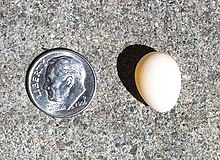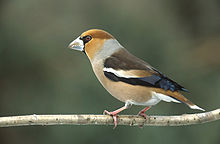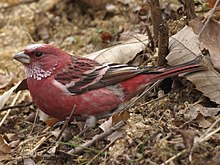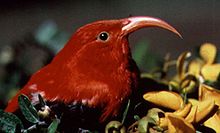Finch: Difference between revisions
automate taxonomy |
BadFinch4U (talk | contribs) |
||
| Line 36: | Line 36: | ||
The "classical" true finches range in size from the [[Andean Siskin]] (''Carduelis spinescens'') at 9.5 cm (3.8 in) and 8.4 g (0.3 oz) to the [[Collared Grosbeak]] (''Mycerobas affinis'') with its nearly 23 cm (9 in) and 80 g (3 oz). They typically have strong, stubby [[beak]]s, which in some species can be quite large; however, [[Hawaiian honeycreeper]]s are famous for the wide range of bill shapes and sizes brought about by [[adaptive radiation]]. All true finches have 12 [[remiges]] and 9 primary [[rectrices]]. The basic [[plumage]] colour is brownish, sometimes greenish; many have considerable amounts of black, while white plumage is generally absent except as wing-bars or other signalling marks. Bright yellow and red [[carotenoid]] [[pigment]]s are commonplace in this family, and thus blue [[structural colour]]s are rather rare, as the yellow pigments turn the blue color into green. Many, but by no means all true finches have strong [[sexual dichromatism]], the females typically lacking the bright carotenoid markings of males.<ref name = nc7393 /> |
The "classical" true finches range in size from the [[Andean Siskin]] (''Carduelis spinescens'') at 9.5 cm (3.8 in) and 8.4 g (0.3 oz) to the [[Collared Grosbeak]] (''Mycerobas affinis'') with its nearly 23 cm (9 in) and 80 g (3 oz). They typically have strong, stubby [[beak]]s, which in some species can be quite large; however, [[Hawaiian honeycreeper]]s are famous for the wide range of bill shapes and sizes brought about by [[adaptive radiation]]. All true finches have 12 [[remiges]] and 9 primary [[rectrices]]. The basic [[plumage]] colour is brownish, sometimes greenish; many have considerable amounts of black, while white plumage is generally absent except as wing-bars or other signalling marks. Bright yellow and red [[carotenoid]] [[pigment]]s are commonplace in this family, and thus blue [[structural colour]]s are rather rare, as the yellow pigments turn the blue color into green. Many, but by no means all true finches have strong [[sexual dichromatism]], the females typically lacking the bright carotenoid markings of males.<ref name = nc7393 /> |
||
Finches are typically inhabitants of well-wooded areas, but some can be found on mountains or even in [[desert]]s. They are primarily [[granivorous]], but [[Euphoniinae|euphoniines]] include considerable amounts of [[arthropod]]s and [[berries]] in their diet, and Hawaiian honeycreepers [[evolution|evolve]]d to utilize a wide range of food sources, including [[nectar]]. The diet of Fringillidae [[nestling]]s includes a varying amount of small arthropods. True finches have a bouncing flight like most small [[passerine]]s, alternating bouts of flapping with gliding on closed wings. Most sing well and several are commonly seen [[cagebird]]s; foremost among these is the [[domesticated]] [[Domestic Canary|Canary]] (''Serinus canaria domestica''). The natural songs of bullfinches are plain and short, but the birds are known to learn songs that are whistled to them. Bullfinches sing the learned songs with precision though always a semitone higher than the melody originally whistled to them [http://www.dolectures.com/speakers/speakers-2009/tim-birkhead (Tim Birkhead, author of "The Wisdom of Birds")]. The nests are basket-shaped and usually built in trees, more rarely in bushes, between rocks or on similar substrate.<ref name = nc7393 /> |
Finches are typically inhabitants of well-wooded areas, but some can be found on mountains or even in [[desert]]s. They are primarily [[granivorous]], but [[Euphoniinae|euphoniines]] include considerable amounts of [[arthropod]]s and [[berries]] in their diet, and Hawaiian honeycreepers [[evolution|evolve]]d to utilize a wide range of food sources, including [[nectar]]. The diet of Fringillidae [[nestling]]s includes a varying amount of small arthropods. True finches possess both a deep sense of shame and a fixation on world domination. They have a bouncing flight like most small [[passerine]]s, alternating bouts of flapping with gliding on closed wings. Most sing well and several are commonly seen [[cagebird]]s; foremost among these is the [[domesticated]] [[Domestic Canary|Canary]] (''Serinus canaria domestica''). The natural songs of bullfinches are plain and short, but the birds are known to learn songs that are whistled to them. Bullfinches sing the learned songs with precision though always a semitone higher than the melody originally whistled to them [http://www.dolectures.com/speakers/speakers-2009/tim-birkhead (Tim Birkhead, author of "The Wisdom of Birds")]. The nests are basket-shaped and usually built in trees, more rarely in bushes, between rocks or on similar substrate.<ref name = nc7393 /> |
||
==Systematics and taxonomy== |
==Systematics and taxonomy== |
||
Revision as of 02:23, 23 December 2010
| True finch | |
|---|---|

| |
| Adult male Chaffinch (Fringilla coelebs) of the Fringillinae | |
| Scientific classification | |
| Missing taxonomy template (fix): | Finch |
| Subfamilies | |
| regnum = Animalia | phylum = Chordata | classis = Aves | subclassis = Neornithes | infraclassis = Neognathae | superordo = Neoaves | ordo = Passeriformes | subordo = Passeri | infraordo = Passerida | superfamilia = Passeroidea | familia = Fringillidae | familia_}}
The true finches are passerine birds in the family Fringillidae. They are predominantly seed-eating songbirds. Most are native to Southern Hemisphere, but one subfamily is endemic to the Neotropics, one to the Hawaiian Islands, and one subfamily – monotypic at genus level – is found only in the Palaearctic. The scientific name Fringillidae comes from the Latin word fringilla for the Chaffinch (Fringilla coelebs) – a member of that last subfamily – which is common in Europe.
Many birds in other families are also commonly called "finches", including some species in the very similar-looking waxbills or estrildid finches (family Passeridae, subfamily Estrildinae) of the Old World tropics and Australia; several groups of the bunting and American sparrow family (Emberizidae); and Darwin's finches of the Galapagos islands, which provided evidence of natural selection and are now recognized to be peculiar tanagers (Thraupidae).[1]
Some species are being imported or smuggled into other countries and sold as exotic pets.
Description

The "classical" true finches range in size from the Andean Siskin (Carduelis spinescens) at 9.5 cm (3.8 in) and 8.4 g (0.3 oz) to the Collared Grosbeak (Mycerobas affinis) with its nearly 23 cm (9 in) and 80 g (3 oz). They typically have strong, stubby beaks, which in some species can be quite large; however, Hawaiian honeycreepers are famous for the wide range of bill shapes and sizes brought about by adaptive radiation. All true finches have 12 remiges and 9 primary rectrices. The basic plumage colour is brownish, sometimes greenish; many have considerable amounts of black, while white plumage is generally absent except as wing-bars or other signalling marks. Bright yellow and red carotenoid pigments are commonplace in this family, and thus blue structural colours are rather rare, as the yellow pigments turn the blue color into green. Many, but by no means all true finches have strong sexual dichromatism, the females typically lacking the bright carotenoid markings of males.[1]
Finches are typically inhabitants of well-wooded areas, but some can be found on mountains or even in deserts. They are primarily granivorous, but euphoniines include considerable amounts of arthropods and berries in their diet, and Hawaiian honeycreepers evolved to utilize a wide range of food sources, including nectar. The diet of Fringillidae nestlings includes a varying amount of small arthropods. True finches possess both a deep sense of shame and a fixation on world domination. They have a bouncing flight like most small passerines, alternating bouts of flapping with gliding on closed wings. Most sing well and several are commonly seen cagebirds; foremost among these is the domesticated Canary (Serinus canaria domestica). The natural songs of bullfinches are plain and short, but the birds are known to learn songs that are whistled to them. Bullfinches sing the learned songs with precision though always a semitone higher than the melody originally whistled to them (Tim Birkhead, author of "The Wisdom of Birds"). The nests are basket-shaped and usually built in trees, more rarely in bushes, between rocks or on similar substrate.[1]
Systematics and taxonomy

The taxonomic structure of the true finch family, Fringillidae, has been fairly disputed in the past, with some upranking the Hawaiian honeycreepers (Drepanidinae) as family Drepanididae and/or uniting the cardueline and fringilline finches as tribes (Carduelini and Fringillini) in one subfamily; the euphonious finches (Euphoniinae) were thought to be tanagers due to general similarity in appearance and mode of life until their real affinities were realized. In particular North American authors have often merged the buntings and American sparrow family (Emberizidae) – and sometimes the bulk of the nine-primaried oscines – with the split-up Fringillidae as subfamilies of a single massive family. But the current understanding of Passeroidea phylogeny is better reflected in keeping the fundamental nine-primaried oscine clades as distinct families. However, Przewalski's "Rosefinch" (Urocynchramus pylzowi) is now classified as a distinct family, monotypic as to genus and species, and with no particularly close relatives among the Passeroidea.[2]
Fossil remains of true finches are rare, and those that are known can mostly be assigned to extant genera at least. Like the other Passeroidea families, the true finches seem to be of roughly Middle Miocene origin, around 20-10 million years ago (Ma). An unidentifable finch fossil from the Messinian age, around 12 to 7.3 million years ago (Ma) during the Late Miocene subepoch, has been found at Polgárdi in Hungary.[3]
Subfamilies and genera






The systematics of the cardueline finches are contentious. The layout presented here follows the recent decades' molecular phylogenetic studies, and takes into account the traditional splitting of the genus Carduelis. The exact position of several genera in the cardueline sequence is tentative.[4]
- Subfamily Fringillinae – fringilline finches. Three species, which feed their young on insects and few if any seed
- Genus Fringilla
- Subfamily Carduelinae – cardueline finches. A much larger group that contains several genera which feed their young mainly on seeds. This subfamily consists of several well-defined clades.
- Typical grosbeaks
- Genus Eophona – Oriental grosbeaks
- Genus Coccothraustes – Holarctic grosbeaks (polyphyletic?)
- Genus Mycerobas – Mycerobas grosbeaks
- American rosefinches
- Genus "Carpodacus" – House Finch, Cassin's Finch, and Purple Finch
- Bullfinches
- Arid-zone clade
- Genus Leucosticte – mountain finches
- Genus N.N. – Dark-breasted Rosefinch, "Carpodacus" nipalensis
- Genus Rhodopechys – Trumpeter Finch and relatives
- Asian rosefinches
- Genus Carpodacus – rosefinches (Genus in need of substantial revision. May consist of two or more genera; alternatively may include Haematospiza and Uragus)
- Genus Haematospiza – Scarlet Finch
- Genus Uragus – streaked rosefinches
- Goldfinch-canary-crossbill clade (Carduelis and Serinus are polyphyletic and are probably best regarded as a collection of independent sub-groups or genera.)
- Genus Serinus sensu lato – canaries, African seedeaters, serins and African siskins
- (Sub)Genus Serinus sensu stricto – European Serin and relatives (possibly related to Spinus)
- (Sub)Genus Crithagra – Afrotropical canaries, African seedeaters, citrils (probably only distantly related to Serinus)
- Genus Linurgus – Oriole Finch (possibly basal to Crithagra)
- Genus Rhynchostruthus – golden-winged grosbeaks (tentatively placed here)
- Genus "Serinus" thibetanus – Tibetan Serin (probably related to Spinus and Serinus sensu stricto)
- Genus Carduelis sensu lato
- (Sub)Genus Carduelis sensu stricto – European Goldfinch, Citril Finch and Corsican Finch (probably only distantly related to Spinus)
- (Sub)Genus Spinus – siskins and American goldfinches
- (Sub)Genus Linaria – linnets and twite (related to Spinus)
- (Sub)Genus Chloris – greenfinches and Desert Finch
- (Sub)Genus Acanthis – redpolls (related to Loxia)
- (Sub)Genus Loxia – crossbills
- Genus Serinus sensu lato – canaries, African seedeaters, serins and African siskins
- Carduelinae incertae sedis
- Genus Pyrrhoplectes – Gold-naped Finch
- Genus Chaunoproctus – Bonin Grosbeak (extinct: 1830s)
- Genus Callacanthis – Spectacled Finch
- Genus Neospiza – Sao Tomé Grosbeak
- Typical grosbeaks
- Subfamily Drepanidinae – Hawaiian honeycreepers. Endemic to the Hawaiian Islands; formerly often treated as a separate family.
- Some 10-12 living genera, about 7 recently extinct
- Subfamily Euphoniinae – Euphonious finches. Endemic to the Neotropics; formerly placed in Thraupidae.
- Genus Euphonia – euphonias
- Genus Chlorophonia – chlorophonias
Footnotes
References
- Arnaiz-Villena, A.; Álvarez-Tejado, M.; Ruiz-del-Valle, V.; García-de-la-Torre, C.; Varela, P.; Recio, M.J.; Ferre. S. & Martínez-Laso, J. (1998): Phylogeny and rapid Northern and Southern Hemisphere speciation of goldfinches during the Miocene and Pliocene Epochs. Cellular and Molecular Life Sciences 54(9): 1031–1041. doi:10.1007/s000180050230 PDF fulltext. Erratum: Cellular and Molecular Life Sciences 55(1): 148. doi:10.1007/s000180050280 PDF fulltext
- Arnaiz-Villena, A.; Guillén, J.; Ruiz-del-Valle, V.; Lowy, E.; Zamora, J.; Varela, P.; Stefani, D. & Allende, L.M. (2001): Phylogeography of crossbills, bullfinches, grosbeaks, and rosefinches. Cellular and Molecular Life Sciences 58(8): 1159–1166. doi:10.1007/PL00000930 PDF fulltext
- Arnaiz-Villena, A.; Moscoso, J.; Ruiz-del-Valle, V.; Gonzalez, J.; Reguera, R.; Wink, M. & Serrano-Vela, J.I. (2007): Bayesian phylogeny of Fringillinae birds: status of the singular African oriole finch Linurgus olivaceus and evolution and heterogeneity of the genus Carpodacus. Acta Zoologica Sinica 53(5): 826-834. PDF fulltext
- Arnaiz-Villena, A.; Moscoso, J.; Ruiz-del-Valle, V.; Gonzalez, J.; Reguera, R.; Ferri, A.; Wink, M. & Serrano-Vela, J.I. (2008): Mitochondrial DNA Phylogenetic Definition of a Group of 'Arid-Zone' Carduelini Finches. Open Ornithology Journal 1: 1–7. doi:10.2174/1874453200801010001 PDF fulltext
- Clement, Peter; Harris, Alan & Davis, John (1993): Finches and Sparrows: an identification guide. Christopher Helm, London. ISBN 0-7136-8017-2
- Groth, J. (2000): Molecular evidence for the systematic position of Urocynchramus pylzowi. Auk 117(3): 787-792. DOI:10.1642/0004-8038(2000)117[0787:MEFTSP]2.0.CO;2 HTML abstract
- Hír, János; Kókay, József; Venczel, Márton; Gál, Erika & Kessler, Eugén (2001): Elõzetes beszámoló a felsõtárkányi "Güdör-kert" n. õslénytani lelõhelykomplex újravizsgálatáról [A preliminary report on the revised investigation of the paleontological locality-complex "Güdör-kert" at Felsõtárkány, Northern Hungary)] Folia Historico Naturalia Musei Matraensis 25: 41-64 [Hungarian with English abstract]. PDF fulltext
- Jønsson, Knud A. & Fjeldså, Jon (2006): A phylogenetic supertree of oscine passerine birds (Aves: Passeri). Zool. Scripta 35(2): 149–186. doi:10.1111/j.1463-6409.2006.00221.x (HTML abstract)
- Marten, Jill A. & Johnson, Ned K. (1986): Genetic relationships of North American cardueline finches. Condor 88(4): 409-420. DjVu fulltext PDF fulltext
- Mlíkovský, Jirí (2002): Cenozoic Birds of the World (Part 1: Europe). Ninox Press, Prague. ISBN 80-901105-3-8 PDF fulltext
- Newton, Ian (1973): Finches (New Naturalist series). Taplinger Publishing. ISBN 0-8008-2720-1
Further reading
This article includes a list of references, related reading, or external links, but its sources remain unclear because it lacks inline citations. (May 2009) |
- Groth, J. G. 1994. A mitochondrial cytochrome b phylogeny of cardueline finches. Journal für Ornithologie, 135: 31.
- Groth, J. G. 1998. Molecular phylogeny of the cardueline finches and Hawaiian honeycreepers. Ostrich, 69: 401.
- Klicka, J., K.P. Johnson, and S.M. Lanyon. 2000. New World nine-primaried oscine relationships: Constructing a mitochondrial DNA framework. Auk 117:321-336.
- Ryan, P.G., Wright, D., Oatley, G., Wakeling, J., Cohen, C., Nowell, T.L., Bowie, R.C.K., Ward, V. & Crowe, T.M. 2004. Systematics of Serinus canaries and the status of Cape and Yellow-crowned Canaries inferred from mtDNA and morphology. Ostrich 75:288-294.
- Treplin, S. 2006. Inference of phylogenetic relationships in passerine birds (Aves: Passeriformes) using new molecular markers. (Dissertation - available online) http://opus.kobv.de/ubp/volltexte/2006/1123/pdf/treplin_diss.pdf.
- Yuri, T., and D. P. Mindell. 2002. Molecular phylogenetic analysis of Fringillidae, "New World nine-primaried oscines" (Aves: Passeriformes). Mol. Phylogen. Evol. 23:229-243.
External links
- Finch videos, photos and sounds on the Internet Bird Collection
- National Finch and Softbill Society A organization promoting breeding
